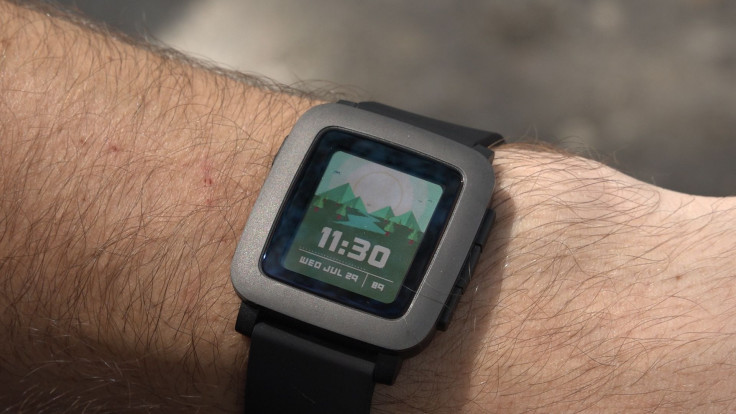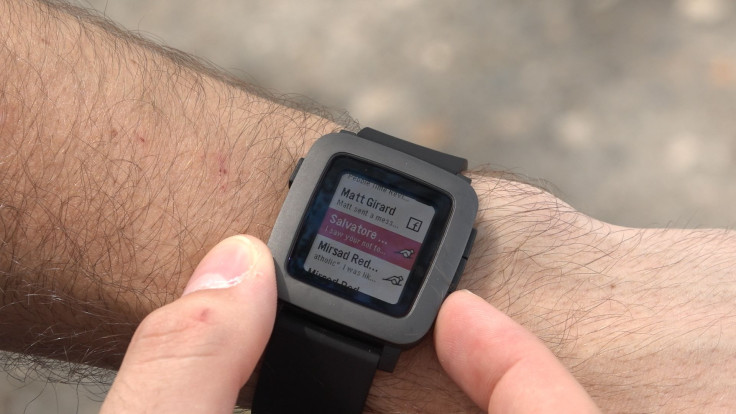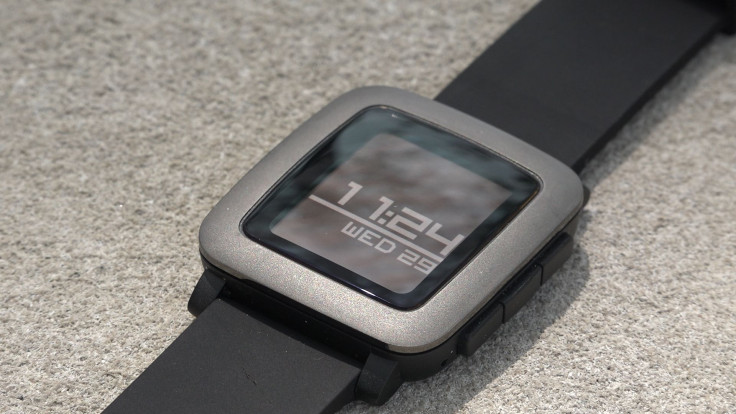Pebble Time Review: A Simple Alternative To Apple Watch, Moto 360, Samsung Gear
When smartwatches first gained a substantial following, the name synonymous with the industry was Pebble, which launched on Kickstarter and became a beloved pioneer of the market. But these days smartwatches are everywhere: titans of technology like Samsung and Motorola make a number of Android-based watches, and the Apple Watch is the most successful smartwatch ever.
Pebble has a great deal more competition than it had even a year ago. And while its latest smartwatch does technically compete with the latest and greatest, but it takes a no-frills approach. While most smartwatches like those are chock full of features, Pebble is sticking to an old-school approach with a simple smartwatch: The Pebble Time.
Whether or not it’s the right approach depends on what you’re willing to sacrifice.
Looks / Aesthetics

The Time certainly isn’t the most chic thing you’ll ever see. The bezel is made of a subdued stainless steel that surrounds a 1.25 inch screen. But it’s not an OLED, as many other are -- it’s an e-Paper display. That’s the same sort of technology seen in e-readers, except it’s in color. It’s not the absolute brightest thing out there, and the colors tend to blend into one another. It’s a far cry from the crispness and contrast that OLED affords, but it’s easy on the eyes, and the animations are charming. The e-Paper means it’s easily legible in sunlight, so you could rely on it just like a traditional watch (plus it’s less energy-hungry, but more on that later). The screen isn’t touch-enabled though, so all of your interactions will be with the physical buttons on either side of the watch body. The Time isn’t the most suave-looking smartwatch out there, but it is funky.
Function
The Time runs on Pebble’s own user interface, dubbed “Timeline.” Instead of opening individual apps from a hub, the watch automatically organizes app events and notifications chronologically. So you can see what’s happening right now, or what will happen in the future, or what already happened by scrolling up and down the timeline. It’s not as robust as something like Android Wear, but it does a great job for quick glances. The watch buzzes for incoming emails, texts, and other notifications, but it doesn’t try to replicate all of your phone’s functionality. It will control your music over Bluetooth though (which is a nice touch) and with Android devices it can also let you reply to texts and emails with voice commands.

The Time is compatible with most Android and iOS phones (sorry Windows phones). Though some have reported issues with iOS, I had no trouble on my Android device running 4.4.2. Either way, Pebble has its own app store filled with add-ons, such as pedometer and sleep applications, to increase the watch’s capabilities.
Battery Life
The Time’s biggest selling point is its longevity. While other big name watches like the Moto 360, Samsung Gear, and Apple Watch barely last a day or two on a charge, the Pebble boasts a weeklong lifespan. In practice, the best I could do was six days before the emergency power saving mode kick on, but that still embarasses most things out there, and it makes the Time much easier to live with. You can thank the low-draw e-Paper display for the Time’s minimal battery draw.
Value
The Pebble Time is $200. That’s not terribly expensive for a decent smartwatch, but consider the range of competition: there are strong Android Wear smartwatches at that price point. The Moto 360 (considered by many to be one of the best Android Wear Watches) and the LG G watch can be had cheaper can both be had for around the same money, yet they’re more capable. Plus there are some more traditional-looking competitors for those who want something closer to a regular watch, like the Withings Activite Pop. Apple Watch Sport starts at $349.
The Time has to rely heavily on its long battery life to sell itself, but Pebble believes “smartstraps” will be available in the future, and those will give the Time new functions like GPS and heart rate monitoring. So if you’re in for the long-haul, the Time could be the smartwatch you keep for years on end, despite its current lack of capabilities.
Conclusion

The Pebble Time is an interesting case -- it’s not as technically advanced as its competition nor is it anywhere near as good to look at, but in many ways it’s more satisfying to use. For $200 it’s worth a look, but only for those who don’t care for Android Wear or the Apple Watch.
© Copyright IBTimes 2024. All rights reserved.












